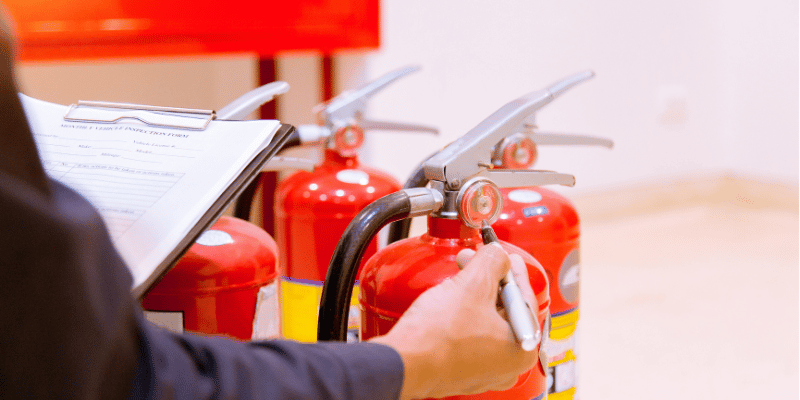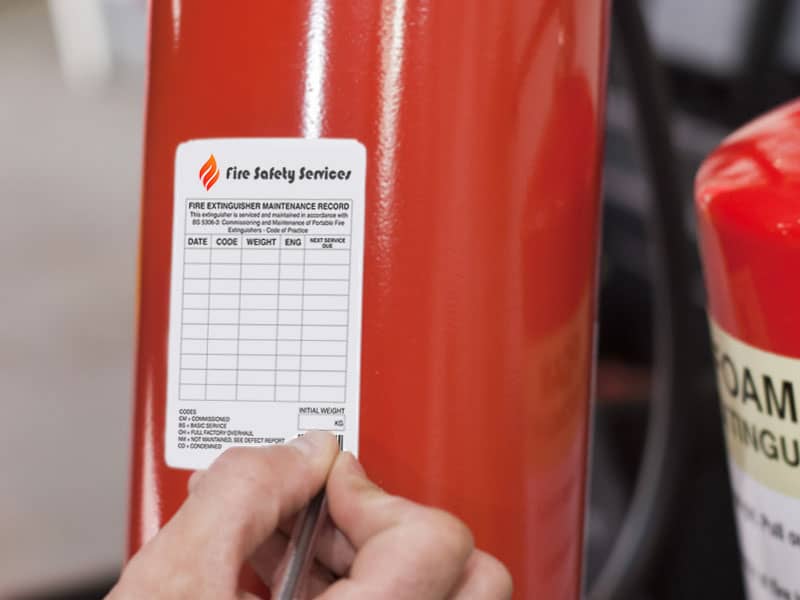Fire Safety Compliance Made Easy:
The importance of using inspection tags
Fire safety compliance is a critical aspect of any organisation’s safety protocols. Ensuring that your fire safety equipment is up to code and regularly inspected is not just a legal requirement but also a matter of utmost importance for the safety of your employees and premises. In this blog post, we will delve into the importance of using inspection tags as a simple yet effective way to achieve and maintain fire safety compliance.

The role of inspection tags in fire safety
Inspection tags are small, but they play a significant role in simplifying the fire safety compliance process. Here’s why they are indispensable:
- Tracking inspections: Inspection tags are attached to fire safety equipment after each inspection. They include essential information such as the date of the inspection and the inspector’s details. This documentation helps in tracking when the equipment was last checked.
- Visual reminder: The presence of inspection tags serves as a visual reminder to both employees and inspectors. It indicates that the equipment is up to date and has been recently inspected.
- Documentation: Inspection tags act as a record of compliance. In case of an audit or inspection by authorities, having these tags in place provides concrete evidence of your commitment to fire safety.
- Maintenance alerts: If an issue is identified during an inspection, the tag can be marked accordingly. This alerts maintenance personnel that immediate attention is needed.
The Significance of Fire Safety Compliance
Before we explore the role of inspection tags, let’s understand why fire safety compliance is crucial:
- Legal Requirements: Various local and national regulations mandate that businesses and institutions adhere to specific fire safety standards. Failure to comply can result in fines, legal troubles, and, more importantly, jeopardise lives.
- Employee Safety: Fire safety compliance measures, such as regular inspections, ensure that fire extinguishers, alarms, sprinkler systems, and emergency exits are functioning correctly. This directly contributes to the safety and well-being of your employees.
- Property Protection: Fire incidents can cause extensive damage to property and assets. Compliance measures help minimize the risk and severity of such incidents, potentially saving your organisation from substantial financial losses.

How to use inspection tags effectively
To make the most of inspection tags for fire safety compliance, follow these best practices:
- Regular inspections: Ensure that inspections are conducted at the recommended intervals. Most fire safety equipment requires monthly, quarterly, or annual inspections.
- Proper attachment: Attach inspection tags securely to the equipment in a visible location. Use durable tags that can withstand environmental conditions.
- Consistent documentation: Maintain an inspection log corresponding to the information on the tags. This creates a comprehensive record of compliance efforts.
Types of inspection tags for fire safety
When it comes to fire safety, various types of inspection tags are employed to meet specific needs and requirements. The most common types include “Monthly inspection,” “Quarterly inspection,” and “Annual inspection” tags. These tags are colour-coded for easy identification, with each colour representing a different inspection frequency. Additionally, “Tamper-evident” tags are designed to show if the equipment has been tampered with or used since the last inspection. “Emergency Exit Inspection” tags are crucial for ensuring the readiness of emergency exit routes. Lastly, “Maintenance required” tags are used to flag equipment that requires immediate attention or repairs. Choosing the right type of inspection tag and using them consistently is key to maintaining a well-organised and compliant fire safety protocol within your organisation.
What equipment needs to be tagged for fire safety?
Equipment that needs to be tagged for fire safety typically includes various fire safety devices and components within a building or facility. Here is a list of common equipment that should be tagged for fire safety:
- Fire extinguishers: Fire extinguishers should be tagged to indicate when they were last inspected, ensuring they are in proper working condition. Fire Extinguisher Tags should be affixed to each fire extinguisher to indicate when the fire extinguisher was last serviced and inspected, and when the next servicing or inspection is due.
- Fire alarm systems: Inspection tags on fire alarm systems help track regular checks to ensure they can detect and notify occupants of a fire.
- Sprinkler systems: Sprinkler systems need to be inspected regularly, and tags indicate when the last inspection was performed.
- Emergency lighting: Tags on emergency lighting systems verify that they are functional, providing illumination during power outages or emergencies.
- Fire hoses and reels: Inspection tags on fire hoses and reels confirm that they are accessible, in good condition, and ready for use.
- Exit signs: Emergency exit signs should have tags to show they are regularly inspected and functioning correctly.
- Fire doors: Fire doors are inspected to ensure they close and latch properly. Tags indicate when this inspection occurred.
- Fire hydrants: In some cases, fire hydrants on the premises may need to be inspected and tagged to ensure they are operational.
- Fire suppression systems: Tags on fire suppression systems, such as CO2 or foam systems, verify their readiness and functionality.
- Smoke detectors: In residential settings, smoke detectors should be tagged to indicate when they were last tested or when their batteries were changed.
- Fire Blankets: Inspection tags on fire blankets can confirm that they are available and in good condition.
- Fire safety equipment cabinets: Tags on cabinets housing fire safety equipment, such as fire hoses or extinguishers, show that the contents are regularly checked and maintained.
- Emergency evacuation maps: Tags on evacuation maps display the date of the last review to ensure they are up-to-date and accurate.
It’s essential to consult local fire safety codes and regulations, as the specific equipment and tagging requirements may vary by region. Regular inspections and proper tagging of these items are crucial to maintaining a safe environment and ensuring compliance with fire safety standards.
Conclusion
Fire safety compliance is a non-negotiable aspect of running a safe and responsible organisation. Using inspection tags simplifies the process by providing a clear and documented record of inspections. By incorporating inspection tags into your safety protocols, you not only meet legal requirements but also prioritise the well-being of your employees and the protection of your assets. Remember, when it comes to fire safety, being proactive is always better than being reactive. So, start tagging today!


